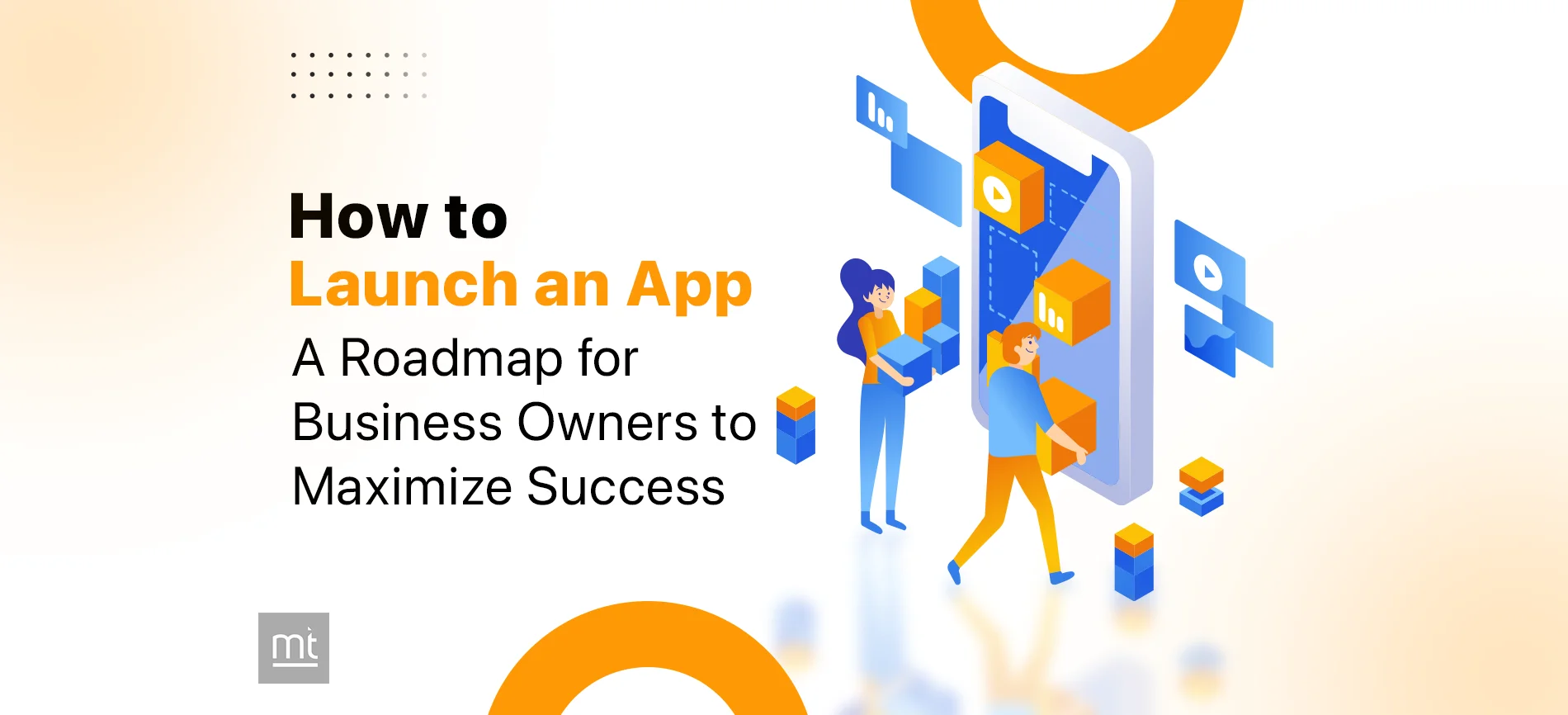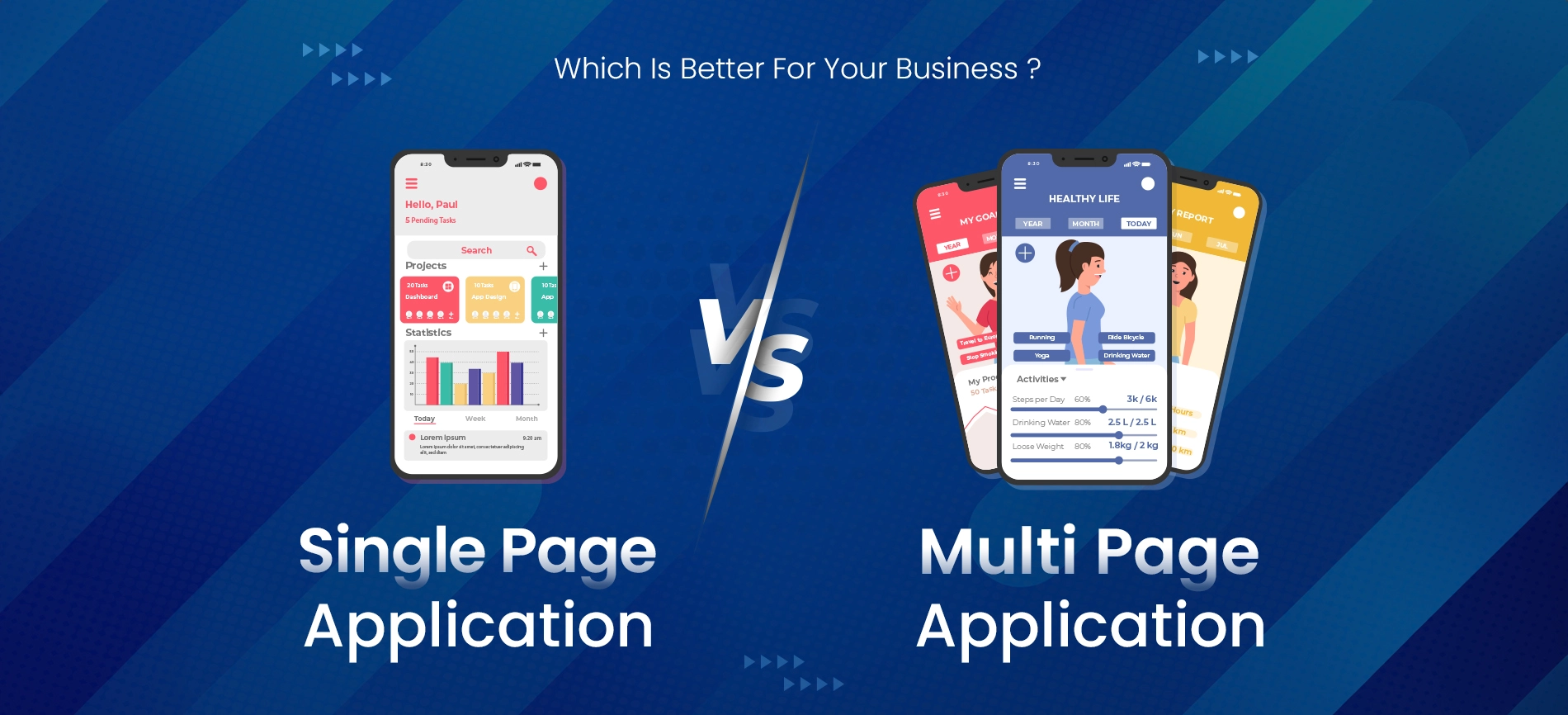Introduction:
Fintech has wholly changed banking, investment management, and financial transactions during the modern technological era. Fintech applications are used by both consumers and businesses to provide unparalleled simplicity, simplify complex financial processes, and enhance user experience.
Because smartphones and internet penetration have proliferated the financial industry, entrepreneurs now have a lucrative chance to develop and use fintech apps. According to reports, it is estimated that the Fintech Market size is set to surpass $600 billion by 2029.
If you follow the right steps for Fintech app development, it can satisfy users while guaranteeing security and regulatory compliance.
This article helps business owners negotiate the numerous aspects of fintech app development.
What is a Fintech App?
A Fintech or financial technology app is a specific kind of application designed and developed to deliver financial services more complex and easily.
These apps have impacted how consumers handle and use money by fostering the use of these modern banking tools, formal banking instruments, and consumers’ preferences.
FinTech banking software may cost anywhere from $30,000 to $300,000, depending on its intricacy.
FinTech applications can be applied to all financial services, such as mobile money services, Mobile payment, E-savings, E-investments, E-loans, and E-insurance.
They decide to provide users with well-designed and convenient services, safe identification for users, immediate feedback for each transaction, and comprehensive financial planning and analysis and data offering services. By 2026, some analysts project the fintech industry to reach over $37 billion.
Types of Fintech App Development
Let’s explore various types of Fintech app development that meets all your finance requirements:
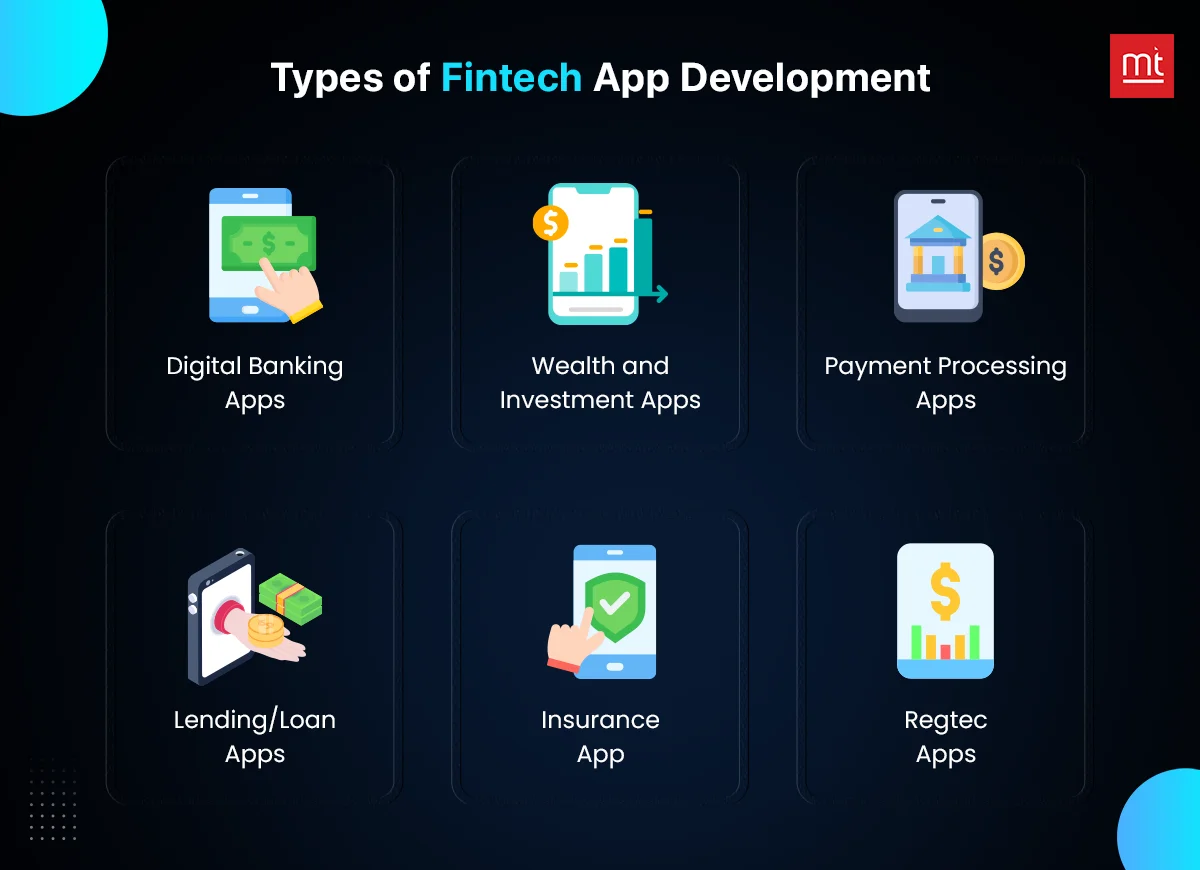
1. Digital Banking Apps
With its easy and safe approach to handling personal and corporate accounts, digital banking applications have completely changed the financial sector. Among the many functions offered by these applications are account management, financial transfers, bill payments, and mobile check deposits.
Their real-time access to transaction history, account balances, and customized financial insights is provided. Advanced security measures, including multi-factor and biometric authentication, are also included in many digital banking applications to protect customers' financial information.
2. Wealth and Investment Apps
Fintech's growth has made wealth management and investment more approachable to a larger range of people. Users of wealth and investment applications may trade stocks, manage their investment portfolios, and get financial advice.
Many times, these applications include sophisticated analytics and data visualization features that let users keep an eye on their assets, keep an eye on market developments, and make wise investment choices.
Specific applications offer robotic investment management based on the user's financial objectives and risk profile.
3. Payment Processing Apps
Apps for handling payments have entirely changed how we handle money. These applications make it easy and safe to use payment options, including QR code-based payments, peer-to-peer payments, and mobile wallets.
For both online and in-store transactions, they provide a smooth checkout process that does away with the need for actual cash or credit cards. Among the widely used payment processing applications are Google Pay, Apple Pay, and various digital wallets provided by banks and other financial companies.
4. Lending/Loan Apps
By launching cutting-edge lending platforms and applications, fintech has upended the conventional lending sector. Borrowers may apply for loans more quickly and conveniently thanks to lending/loan apps.
These applications evaluate creditworthiness, provide customized loan offers, and enable quick approvals using sophisticated algorithms and data analytics. Even peer-to-peer lending, which links borrowers directly with individual or institutional investors, is a feature of specific lending applications.
5. Insurance Apps
The insurance industry's acceptance of fintech technologies produces a new generation of insurance applications. Among the many features these applications provide are claims processing, premium payments, and policy administration.
They provide consumers with a single place to handle their insurance plans, keep an eye on policy specifics, and quickly submit claims. In addition, several insurance applications use the Internet of Things and telematics to provide use-based insurance plans tailored to specific usage or driving habits.
6. Regtech Apps
Apps known as regulatory technology, or regtech, are made to assist financial organizations in efficiently managing risks and adhering to often changing regulatory standards. These applications use cutting-edge technology to automate compliance procedures, spot any hazards, and guarantee regulatory requirements are followed.
Examples of these technologies include artificial intelligence, machine learning, and data analytics. Regtech applications lighten the load on financial institutions and improve general compliance by streamlining procedures like regulatory reporting, anti-money laundering (AI/ML) monitoring, and Know Your Customer (KYC) procedures.
Features to Integrate while Developing Fintech App Development
Features decide the growth of Fintech App, and that is why it is important to integrate the right features to develop leading applications. Here, explore the top features to include while building Fintech Applications:
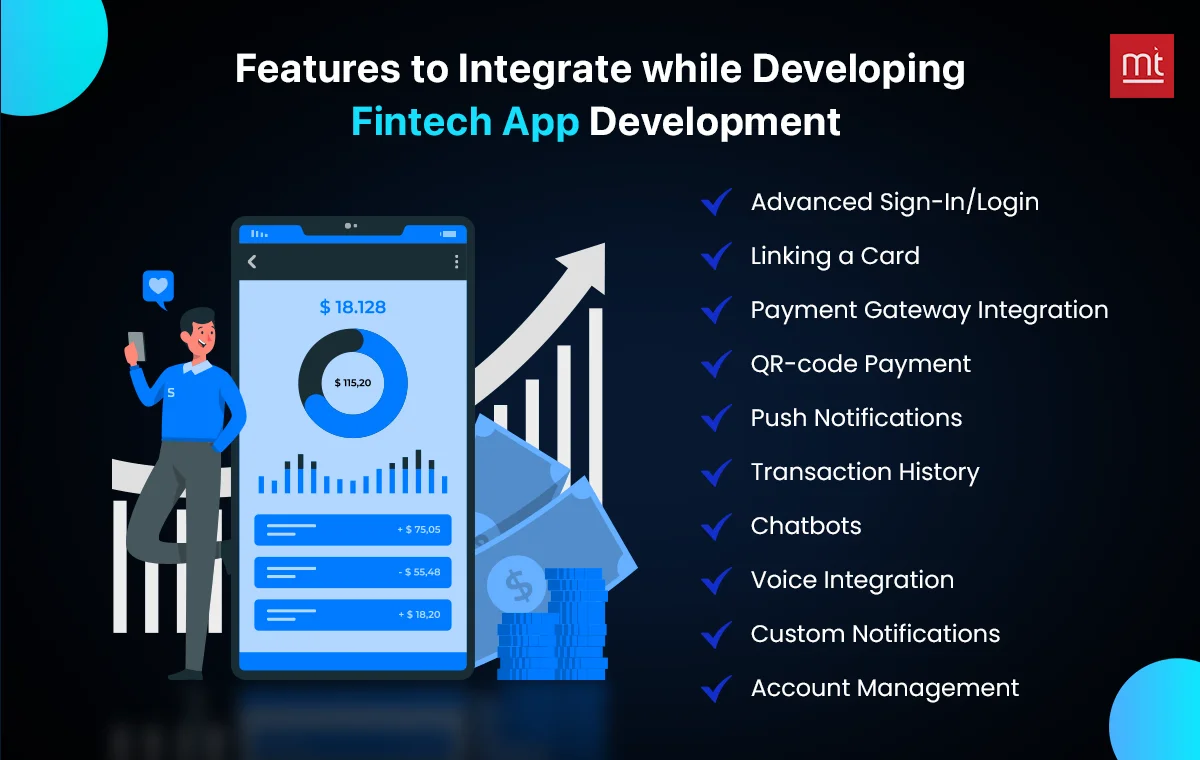
Advanced Sign-In/Login
Given the sensitive financial data fintech applications handle, strong authentication procedures are essential. Using two-factor authentication (2FA), secure digital signatures, or biometric authentication (fingerprint, face, or iris scanning) can greatly improve user account security and guard against fraud or unauthorized access.
Linking a Card
A basic function that enables smooth financial transactions is letting customers connect their credit or debit cards to the FinTech app. This functionality should enable safe card registration, secured card data storage, and app-based management of many cards.
Payment Gateway Integration
Securing and dependable financial transactions within the app needs integration with well-known payment gateways. Credit/debit cards, digital wallets, and other payment mechanisms like mobile money or bank transfers should all be supported by this functionality. User trust and data security depend on ensuring adherence to industry norms and laws.
QR-code Payment
The frictionless and practical payment experience provided by QR-code payment technology has seen tremendous growth in popularity recently. Improving the user experience overall, the FinTech app may simplify transactions for in-store purchases, peer-to-peer payments, or bill settlements by including a QR-code payment capability.
Push Notifications
Keeping users updated and involved with the app is largely made possible via push notifications. Putting in place real-time push notifications may notify consumers of promotions, account activity, transaction confirmations, and significant changes. Customizable notification settings let users choose the kinds and frequency of alerts they receive.
Transaction History
Transparency and budgetary goals depend on giving consumers a thorough record of their financial activities. Dates, sums, descriptions, and classification choices should all be shown in full via the transaction history function. Furthermore, the user experience can be improved through sophisticated filtering and search features.
Chatbots
Including chatbots or virtual assistants in the banking app may provide consumers individualized and quick assistance. Chatbots may answer frequently asked inquiries, walk users through program features, or perform basic financial transactions. Combining machine learning and natural language processing (NLP) may make more sophisticated and contextually aware chatbot conversations possible.
Voice Integration
With voice integration, users of financial apps may manage their money hands-free. Voice commands may be utilized for things like starting transactions, looking up account balances, or getting financial information. Voice assistants may improve convenience and accessibility, especially for those with special needs or on the road.
Custom Notifications
User engagement and retention may be much increased by personalized alerts based on user preferences and financial objectives. Reminders for bills, notices of approaching deadlines, or tailored financial advice depending on spending habits or investment objectives are examples of custom notifications.
Account Management
Consumers need strong account management capabilities to manage their money within the app fully. This needs to include the capacity to monitor spending, create budgets and savings targets, examine and update personal information, and handle many accounts or profiles.
Steps to Build a Fintech Application
Here is the list of step by step processes that you must follow to build top notch Fintech Application:
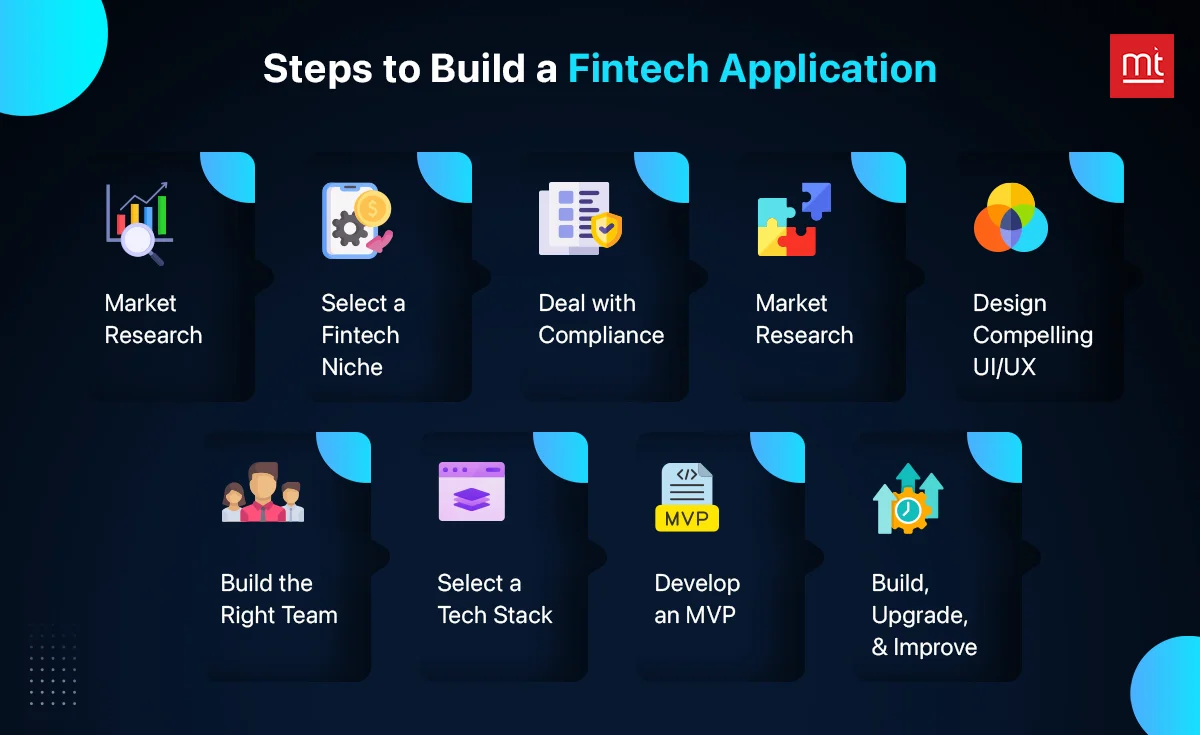
Step 1: Market Research
Market research is the first and foremost part of every profitable financial app development project. It entails evaluating the market, areas of consumer suffering, competing goods, changes in the sector, and laws. This paper confirms the idea of the app, pinpoints the intended market, and highlights opportunities for innovation and uniqueness.
Step 2: Select a Fintech Niche
Digital banking, investment management, payments, loans, insurance, and other services are all part of the fintech industry. Selecting a specialty serves to focus your resources and efforts. Your app may provide the most value and stand out by offering a better user experience, special features, or catering to a neglected market.
Step 3: Deal with Compliance
Fintech apps need to abide by stringent rules governing financial services. Discover the laws, licenses, and certifications of your target market. Financial authority licenses, KYC protocols, AML requirements, and data privacy regulations may all apply. Early advice from legal and regulatory experts will ensure compliance.
Step 4: Define Feature Set
Using market research and fintech experience, define your app's key features and functionalities. This needs to represent the users' needs, areas of suffering, industry best practices, and emerging trends. Make an implementation plan and rank features according to importance and impact.
Step 5: Design Compelling UI/UX
The success of fintech apps is dependent on UI and UX design. Apps with good design are easy to use, attractive, and direct. Emphasize design accessibility, clarity, and simplicity. User testing and comments enhance the UI/UX, smoothen, and enjoy the user experience.
Step 6: Build the Right Team
Organize a knowledgeable group of people to carry out your financial app concept. Examples include marketers, financial experts, product managers, developers, and designers. Development and delivery done well need an agile and cooperative atmosphere.
Step 7: Select a Tech Stack
Developing secure, expandable, and robust financial software requires the right technology stack. Think about databases, cloud platforms, React Native, Flutter, Java, Python, Swift programming languages, and frameworks. Select technology that fits the requirements, team capabilities, and expansion objectives of your project.
Step 8: Develop an MVP
Before investing a great deal in financial software, create a Minimum Viable Product. An MVP is an essential piece of software that enables you to test ideas, get user feedback, and modify them before development.
Step 9: Build, Upgrade, and Improve
Before creating the financial app, launching and testing the MVP is important. Monitor the users’ feedback, statistics, and other related industries to look for improvements and new functions. Due to the flexibility of the approach, it is possible to introduce new features and improvements into the application, which helps achieve and maintain competitiveness and meet customers’ needs.
Cost to develop Fintech App Development
Development Stage | Cost Range (USD) |
Market Research | $5,000 - $15,000 |
UI/UX Design | $10,000 - $50,000 |
MVP Development | $50,000 - $150,000 |
Compliance & Legal Fees | $10,000 - $50,000 |
Backend Development | $40,000 - $150,000 |
Frontend Development | $20,000 - $100,000 |
Testing & QA | $10,000 - $30,000 |
Marketing & Launch | $10,000 - $50,000 |
Maintenance & Updates | $5,000 - $20,000 per year |
The costs connected with the development of fintech apps are highly dependent on various factors including the goal and size of the innovation. Functional and design specifications cost between $5,000 -$ 50,000 to ensure that the software meets the customer’s requirements for usability for functionalities. These may include key functionalities, customers’ group, key characteristic, could be covered in a $50,000-$150,000 MVP.
Disbursements on legal costs and compliance to the Financial Regulatory can be in the range of $ 10, 000 to $ 50, 000. Costs of web design range from $60, 000 to $250, 000 for work done at the frontend and backend. Testing ensures that the software performs as expected and this costs between 10,000 and 30,000 dollars.
The cost for initial promotions and app launch is usually between $10,000 and $50,000. Maintenance of the current has to be made, costing $5000 to $20000 each year.
How Can ManekTech Help You In Fintech App Development?
Manektech is a leading software, web and mobile app development company, offers businesses and new entrants of the financial software development solution. It incorporates the app development life cycle, staff experience in their fields, and an appreciation of fintech.
Altogether, their expertise ensures that the software you are developing, whether as a financial service specializing software or a start-up fintech company, your product complies with safety measures and legal necessities pertinent to the ever evolving financial service industry.
The industry’s specialized team at ManekTech creates various, secure, usable, and sophisticated financial applications for your organization now with up-to-date tools and frameworks.
Another approach that ManekTech can use to allow your financial software to always be state-improving and that new features could be incorporated easily is through agile development. They employ UI/UX designers to target usability, moderate colour contrast, and few links and buttons to achieve an aesthetically pleasing and satisfying UI style.
Conclusion
This can only be possible when there is a powerful and full-featured application which, if forced to operate in such a competitive and dynamic environment as the banking sector, must be able to provide all of these. Thus, by integrating the step-by-step approach, businesses and entrepreneurs can control the processes of fintech application development and potentially provide the necessary solutions to fit the new tendencies in the banking industry.
To make the app work, it is essential to have pre-beta development, team selection, features set integration, market, financial, and specializations research activities.
At ManekTech, we help businesses to envision and execute innovative Fintech solutions, to help clients in offering a superior banking experience much higher in security as well as compliance, together with customer satisfaction.
With this in mind, if you are willing to trust us by relying on ManekTech, we assure you that your application development project is in safe hands and will surely be ready to deliver the best and most effective solutions for your desired application.Contact us today and give an expert hand to your Fintech app development.
About Author
Recent Blogs
Subscribe to Our Newsletter!
Join us to stay updated with our latest blog updates, marketing tips, service tips, trends, news and announcements!


